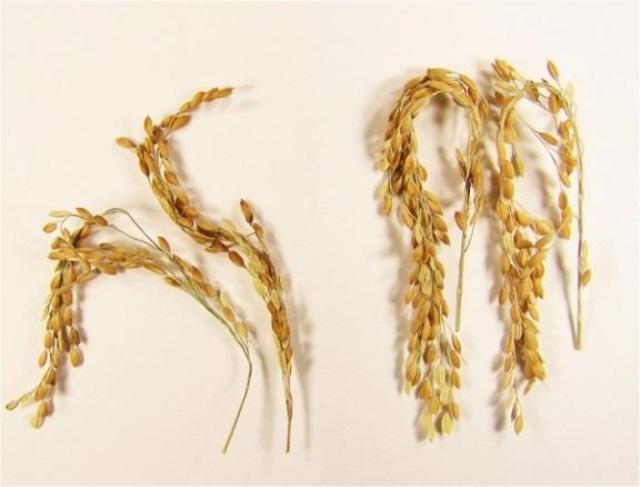Jul 31 2015
Rice serves as the staple food for more than half of the world's population, but it's also the one of the largest manmade sources of atmospheric methane, a potent greenhouse gas. Now, with the addition of a single gene, rice can be cultivated to emit virtually no methane from its paddies during growth. It also packs much more of the plant's desired properties, such as starch for a richer food source and biomass for energy production, according to a study in Nature.
 In addition to a near elimination of greenhouse gases associated with its growth, SUSIBA2 rice produces substantially more grains for a richer food source. The new strain is shown here (right) compared to the study's control. Credit: Image courtesy of Swedish University of Agricultural Sciences
In addition to a near elimination of greenhouse gases associated with its growth, SUSIBA2 rice produces substantially more grains for a richer food source. The new strain is shown here (right) compared to the study's control. Credit: Image courtesy of Swedish University of Agricultural Sciences
With their warm, waterlogged soils, rice paddies contribute up to 17 percent of global methane emissions, the equivalent of about 100 million tons each year. While this represents a much smaller percentage of overall greenhouse gases than carbon dioxide, methane is about 20 times more effective at trapping heat. SUSIBA2 rice, as the new strain is dubbed, is the first high-starch, low-methane rice that could offer a significant and sustainable solution.
Researchers created SUSIBA2 rice by introducing a single gene from barley into common rice, resulting in a plant that can better feed its grains, stems and leaves while starving off methane-producing microbes in the soil.
The results, which appear in the July 30 print edition of Nature and online, represent a culmination of more than a decade of work by researchers in three countries, including Christer Jansson, director of plant sciences at the Department of Energy's Pacific Northwest National Laboratory and EMSL, DOE's Environmental Molecular Sciences Laboratory. Jansson and colleagues hypothesized the concept while at the Swedish University of Agricultural Sciences and carried out ongoing studies at the university and with colleagues at China's Fujian Academy of Agricultural Sciences and Hunan Agricultural University.
"The need to increase starch content and lower methane emissions from rice production is widely recognized, but the ability to do both simultaneously has eluded researchers," Jansson said. "As the world's population grows, so will rice production. And as the Earth warms, so will rice paddies, resulting in even more methane emissions. It's an issue that must be addressed."
Channeling carbon
During photosynthesis, carbon dioxide is absorbed and converts to sugars to feed or be stored in various parts of the plant. Researchers have long sought to better understand and control this process to coax out desired characteristics of the plant. Funneling more carbon to the seeds in rice results in a plumper, starchier grain. Similarly, carbon and resulting sugars channeled to stems and leaves increases their mass and creates more plant biomass, a bioenergy feedstock.
In early work in Sweden, Jansson and his team investigated how distribution of sugars in plants could be controlled by a special protein called a transcription factor, which binds to certain genes and turns them on or off.
"By controlling where the transcription factor is produced, we can then dictate where in a plant the carbon - and resulting sugars - accumulate," Jansson said.
To narrow down the mass of gene contenders, the team started with grains of barley that were high in starch, then identified genes within that were highly active. The activity of each gene then was analyzed in an attempt to find the specific transcription factor responsible for regulating the conversion of sugar to starch in the above-ground portions of the plant, primarily the grains.
The master plan
Upon discovery of the transcription factor SUSIBA2, for SUgar SIgnaling in BArley 2, further investigation revealed it was a type known as a master regulator. Master regulators control several genes and processes in metabolic or regulatory pathways. As such, SUSIBA2 had the ability to direct the majority of carbon to the grains and leaves, and essentially cut off the supply to the roots and soil where certain microbes consume and convert it to methane.
Researchers introduced SUSIBA2 into a common variety of rice and tested its performance against a non-modified version of the same strain. Over three years of field studies in China, researchers consistently demonstrated that SUSIBA2 delivered increased crop yields and a near elimination of methane emissions.
Next steps
Jansson will continue his work with SUSIBA2 this fall to further investigate the mechanisms involved with the allocation of carbon using mass spectrometry and imaging capabilities at EMSL. Jansson and collaborators also want to analyze how roots and microbial communities interact to gain a more holistic understanding of any impacts a decrease in methane-producing bacteria may have.